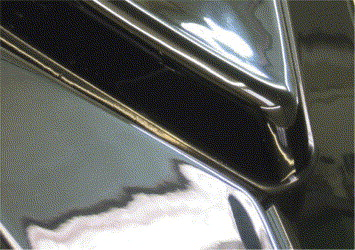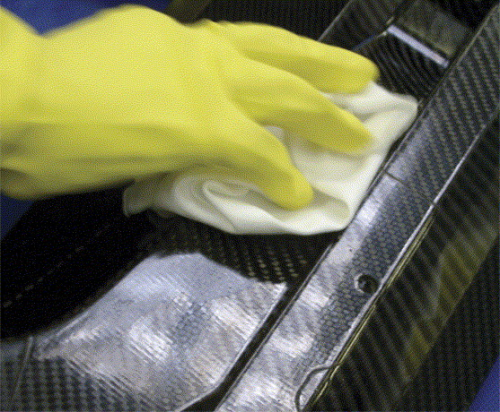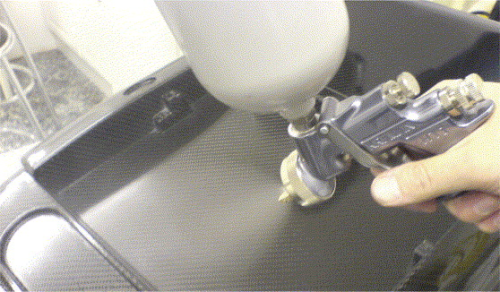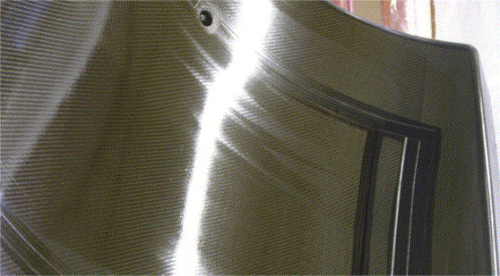



To a composite moulder, the choice of release agent is simple; they want one ‘that works, cheaply.’ However, there are many release agent properties that are either inherently expected or desired when making this choice.
For a composite moulder, the ideal release agent should:
- be non-toxic and safe to use – ideally a water-based system;
- be quick and easy to apply to any mould configuration – i.e. a one-component system with a low viscosity;
- form a complete and uniform film on the mould surface;
- dry or solidify quickly to minimise production down time;
- produce a film thin enough to preserve all mould detail, prevent rapid release agent build-up on the mould and maintain part geometry;
- be insoluble in the polymer being moulded and withstand polymer processing conditions (eg. temperature, pressure, shear and other abrasive forces), i.e. remain at the polymer/mould interface;
- be chemically inert and possess a surface energy lower than the resin or polymer being moulded i.e. give easy release to a wide range of polymeric materials (generally, the lower the surface energy of the release film, the easier the release);
- have a low coefficient of friction to facilitate easy release from deep or complex moulds;
- keep the mould clean for as long as possible, i.e. prevent resin build-up on the mould;
- give a controlled release, i.e. prevent pre-release and ‘fish-eyes’;
- give no transfer to the moulded surface;
- have a long shelf life (>6 months) and not require mixing before use; and
- be low cost, i.e. give the lowest cost per part.
Unfortunately, many of the above properties are only found at the expense of another, eg. a fast drying product is difficult to achieve in a water-based system. This paper discusses many of the issues that face composite moulders and how the release agent manufacturer has tried to solve them.
Wax
Historically, the most common types of release agents have been naturally occurring waxes and greases. Even today, wax remains the most common form of release agent and one that everyone is familiar with.
The majority of these products are based on either carnauba or bees wax. Sold in either paste or liquid form, they are relatively safe and easy to use. Their main disadvantage, as anyone who has used them will testify, is that they are very slow and laborious to apply. In addition, they typically only last for one or two releases before they have to be re-applied, and being wax based means they are not suitable for warm or hot moulding processes.
This type of release agent is often described as a sacrificial release agent; these are products that have to be applied every moulding cycle and release by cohesive failure, i.e. act sacrificially. However advances in various branches of chemistry over the last 30 years have led to the development of a different technology, often referred to as semi-permanent mould release agents (SPMRAs).
SPMRAs
As the name implies, SPMRAs are designed to enable more than one release to be obtained per release agent application. This greatly reduces cost and cycle times when compared to traditional sacrificial release agents. It also has the major added benefit of providing minimal transfer of the coating to the moulded component. A SPMRA achieves these properties by forming a hard or rubbery film (i.e. non-greasy), while maintaining the other requirements of a release agent.
SPMRAs are typically reactive, cross-linkable resins formulated or dissolved in various inert solvents. They are applied directly to the mould surface and, by a process of solvent evaporation and solute cure, form a complete, uniform thin film over the entire mould surface. Although the production of a crosslinked film tends to slightly increase the force required for release (compared to a wax or silicone SMRA), it also increases the durability of the film and thus enables many releases to be obtained from one application.
As mentioned above, the increased durability of the SPMRA also results in a significant decrease in the amount of transfer from the coated mould to the released polymer, often to such an extent that secondary processing, eg. painting or bonding, can be performed without a separate surface preparation stage. This property can be of vital importance in composite manufacture where bond failure can be extremely costly. The only release agent capable of this is a SPMRA.
When applied to a mould surface, the resin used in the SPMRA is in its reactive state. Depending on the reactivity of the SPMRA resin (and there are several types), a chemical reaction occurs with the mould surface. This ensures the release agent remains on the surface of the mould and is not removed with the part when release occurs. The crosslinking of the resin then produces an inert coating of low surface energy capable of releasing most polymers.
The two main crosslinking mechanisms used are moisture cure and heat cure. The former is used to cure solvent-based systems; the latter is used to cure water-based systems. This has an obvious consequence of solvent-based systems having to be stored in sealed containers and of water-based systems being used in hot moulding processes (>60°C).
SPMRAs are highly effective release agents generally having solids contents of 0.25-3%, much lower than sacrificial release agents (a typical paste wax is approximately 30% solids), but as they are reactive and bond to the mould surface they tend to give a much dryer and harder film with relatively low slip and are therefore not suitable for all applications. They also tend to be less user-friendly than waxes, and require a cure time after application (although waxes do need to be left to harden before polishing).
The following discussion of composite moulding processes omits the more common forms of processing used to produce non-structural components, such as sheet moulding compound (SMC), bulk moulding compound (BMC) and various forms of injection moulding.
Glass reinforced polyester
Relative to the composite moulding techniques for non-structural components, the moulding of structural components is a slow, labour intensive process. The simplest, but by no means simple, is that of open face glass reinforced polyester (GRP) moulding. This process is responsible for the manufacture of large consumer structures such as boats, bath tubs and showers, swimming pools and recycling bins.
Open face GRP moulding relies on the painstaking process of polyester resin and glass fibre lay-up using spray, brush or roller techniques. Both mould and part are made using the same fabrication process.
The traditional release agent for this industry is a paste wax, usually carnauba based. As mentioned earlier, paste waxes are extremely slow and laborious to apply; the wax being wiped on, allowed to dry and harden, and then polished. Due to the large surface areas often found in the industry, wax application may take several days and has to be repeated every cycle.
However over the last 10-15 years we have seen the SPMRAs replace these wax applications due to their ability to reduce the application time drastically and significantly increase production rates, especially seen in the larger moulds where application with waxes can take several days.
The answer to this was to spray the SPMRA. Although virtually all SPMRAs can be sprayed, the surface finish produced when spraying a standard SPMRA is poor, with various other problems, such as pre-release and fish-eyes also being common. This led to the development of products specifically designed for spray application. These products (such as Marbocote Spraycote) can be applied 20x faster than a paste wax; give an instant high gloss (even on black gel-coat; see Figure 1) without the need for polishing (a high gloss finish is only obtained from a high gloss mould; these products do not enhance gloss) and give multiple release.
| Product | Number of coats | Coverage(1) (g/m2) | Application time(2)/20 m2 (hr) | Touch-up coat: total time(3) (hr) |
| Paste wax | 9(4) | 12 | 24 | 2.67 |
| Standard wipe applied SPMRA | 7(4,5) | 20 | 11.5 | 1.5 |
| Spraycote | 5 | 25 | 1.5 | 0.75 |
(1) Coverage for total number of coats.(2) Application times are quoted for one person.(3) Total time includes final cure time which is invariably longer for SPMRAs than the cure time between coats.(4) Manufacturer's recommended application.(5) Two coats of sealer, five coats of topcoat.
Clearly, the time saving is dramatic. Even though the unit cost of the spray-applied SPRMA is typically much higher than a paste wax, or even other types of wipe applied SPMRA, the time saving alone more than justifies its use. This is especially true for coating large moulds or when a fast cycle time is required and it is in these processes where spray-applied SPMRAs are becoming generally accepted.
As mentioned earlier, one desirable property is generally offset by an undesirable one. With spray applied products the main disadvantage is that there is no physical contact with the mould. Consequently, the mould must be in good condition (i.e. clean and possessing the desired gloss finish) before the product is applied; the spray-applied product will not fill scratches on the mould surface as a paste wax will. Basically, with spray-applied products, what you see is what you get.
Additionally, this ‘no contact’ application means that dust or resin/polymer build-up on the mould is simply coated with release agent. This tends to exacerbate any build-up problem; hence, in processes where build-up is prevalent, a spray-applied product may not be the best solution. Resin transfer moulding (RTM) and other closed mould processes tend to suffer from build-up issues, mainly on the ‘B’ (non-gelcoated) face.
RTM/closed mould processes (including infusion)
Over recent years we have seen a significant increase in closed mould processes as a way to increase productivity and the quality of components. The process is used extensively for companies producing many parts per week for the transportation, automotive and other markets. Because of the nature of producing parts by injecting/infusing parts, normal sacrificial releases were found to be unsuitable due to the flow of the resins and the ‘mobility’ of the release agent which moves over the mould with the resin.
In these processes, mould turn-around becomes crucial and mould maintenance needs to be minimised, therefore SPMRAs are ideally suited for this process. While conventional SPRMAs solved the initial release problems they did not achieve the high level of releases seen in the hand lay-up market and the mould preparation and cleaning/re-application cycles were seen as too long and created bottlenecks in production.
Furthermore, polyester or vinyl ester closed mould processes suffer from polystyrene build-up on the B face surface, dulling the surface and further reducing the number of cycles between reapplication of the release agent and mould cleaning.
Over recent years new product develop-ments in SPMRAs have been focused to solving the above issues. These developments have focused on several areas:
- capability of giving an instant gloss without the need of a separate wipe/polish process;
- increase application time by removing the need to seal moulds;
- ability to drastically reduce the mould preparation time;
- reducing the frequency of release agent re-application;
- significantly extended mould cleaning cycles; and
- address issue of styrene build up on non-gel coated surfaces.
By addressing these areas we can bring significant benefits to the manufacturers of RTM/closed mould components, dramatically lowering production costs and increasing production rates.
However, as mentioned above, build-up on the mould surface, particularly on the B face (non-gel-coated face) is a problem commonly experienced in closed mould processes. This build-up leads to progressively poorer release which can cause defects in the components, reduced production and increased mould maintenance. Again, recent developments in SPMRA technology have helped solve this problem. Products (such as Marbocote 516FC) have been specifically formulated for the non-gel-coated surface by removing resin build-up during their re-application. This helps keep the mould cleaner for longer without the need for a separate cleaning process.
The build-up is particularly prevalent with more aggressive polymers (such as dicylcopentadiene/DCPD resins) or as a result of the abrasive nature of a particular moulding process. For these processes, it has been found that a combination of an internal mould release agent (IMR) (such as Wurtz PAT 651/DCL and Marbocote 516FC) is particularly effective in not only releasing DCPD resins but also keeping the mould clean. If either product is used independently, the results are not as good as when used in combination.
Advanced composites (prepreg/epoxy)
The traditional process for the manufacture of ‘advanced’ composites uses the prepreg/vacuum bag/autoclave process to produce lower numbers or higher specification components. This is typically used in aerospace and other ‘high tech’ applications. In the majority of these processes the cost of the parts produced are normally of a high value but low on quantities therefore the needs of this industry are very different from say the RTM or GRP markets.
The main criteria for a release agent is a non-transferring/contaminating release agent that will give a high quality surface finish and have the ability to produce one-off parts in a relatively quick time eg. motorsport components. Most of the parts produced require painting or bonding after their release and they are used in very critical applications (aerospace) where contamination of the components surface becomes a real issue.
The SPMRAs are ideally suited for these applications because of their non-contaminating release and the ability to give a very high gloss finish with a fast application and moulding time, especially with the use of autoclave (heat) in most of the applications. By having a non-contaminated release the producer can reduce the amount of cleaning and preparation time required before painting and/or bonding.
Because of the high demands in these markets, especially aerospace, the main original equipment manufacturers (OEMs) will become heavily involved in the selection process of a release agent and will give their own material approvals/specifications for individual components (eg. Boeing).
Because of the above issues and the prohibition of the use of silicones, SPMRAs are almost exclusively used in this market.
The key area of development in this arena has occurred as a result of environmental issues with the desire to move away from solvent-based products to water-based. The question is, however, whether the advanced composite moulder is willing to compromise on either the release agent application technique or release agent performance in order to achieve the environmental goal.
Environmentally friendly technology
The majority of SPMRAS are solvent-based products based on moisture cure resins in a non-polar solvent carrier. The grade of solvent, usually aliphatic hydrocarbon, can be easily changed to account for application temperature; a fast drying solvent used for room temperature application, a slow drying grade for high temperature application. The simple intent is to wet the mould surface in order to give a thin uniform film of release agent.
However, concern for environmental safety, as well as increasing regulation, have spurred on the development of water-based release agents. Water-based releases operate on the same technology principle as solvent-based products, with a carrier evaporating to leave the resin chemically bonded to the mould surface. However, while solvents evaporate quickly at room temperature, water evaporates slowly, which lengthens the drying and curing time and also affects the performance of the release agent. Therefore to maximise the performance of these water based products, heat is often required in the production process.
Several water-based products are already available that claim to be water-based, room temperature curing semi-permanent release agents. Care should be exercised when evaluating these products as they tend to be simple silicone emulsions with no curing mechanism. These products are often emulsions of so called ‘paintable’ silicones – polydimethylsiloxanes with a partial methyl substitution with a more polar entity such as an aminopropyl or aryl group. The fact that more than one release can be obtained per application is no indication of their being ‘semi-permanent’ in nature; non-curing silicones can give up to 20 releases from one application. Transfer to the release surface (and to anything else they come into contact with) will always accompany this type of release agent.
True water-based SPMRAs have been used successfully in rubber/elastomer industries for many years where heat is a common factor in the production process. In the composite market the manufacturer will need to look at changing the way the release agent is applied by utilising heat in the process, whether it be an autoclave, infrared heaters or water heated moulds etc. Consequently, although application can be at room temperature, a heat cure (to a least 60°C) is required for the product to exhibit true ‘semi-permanent’ properties.
In addition, the wetting of a water based release agent is also difficult; due to its high surface tension, water will not naturally wet a polymeric surface. Consequently, surfactants have to be used to aid wetting (see Figure 2).
The choice of surfactant and the amount used is critical; large amounts of surfactant can not only help the release agent to wet the surface but will also help the resin wet the release agent. The consequence may prevent any release at all. A further difficulty is the ability of the liquid release agent to wet itself, i.e. to wet its own cured film. If this is not achieved, then a poor film results giving poor cosmetics on the released surface.
To date, the processing and performance compromises that the moulder has to make to use the water-based SPMRA has slowed its introduction – many want the water-based option but are unwilling to accept any compromise. The old adage, “I want it all, and I want it now”, springs to mind.
Choice
There is now a greater choice of release agents available to the market, which in turn has created problems in how to decide which release agent is the right one for you. Due to their widely different properties and the large number of composite moulding processes in which they are used, choosing the appropriate release agent for a particular application is often a compromise. It is clear from our experience of many years of service and supply to the market that the main requirements for a release agent are as follows:
- guaranteed release;
- quick and easy to apply;
- low cost per part;
- high quality finish;
- low defect rate; and
- no processing problems.
Over the last decade we have seen major developments in the field of semi-permanent mould release agents that have positioned these products at the forefront of the composites market as the solution to its moulding issues. They have begun to deliver an all-round performance that can meet the demands of almost all moulding processes using a wide variety of materials. This process simplification along with the additional benefits of reduced application time, greater production through-put, reduced mould maintenance, and the resulting lowest cost per part, make these release agents the products of choice for composite processors in the 21st century.






